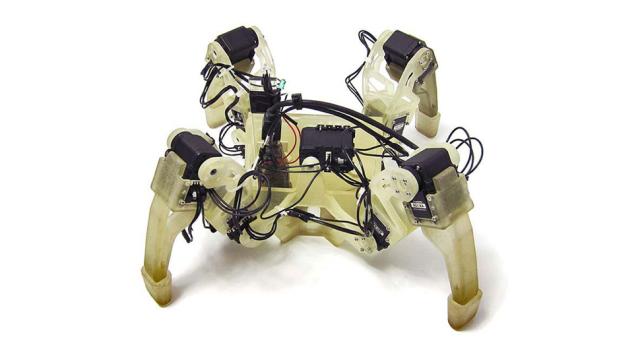In a laboratory tucked away in a corner of the Cornell University campus, Hod Lipson’s robots are evolving. He has already produced a self-aware robot that is able to gather information about itself as it learns to walk. Like a Toy Story character, it sits in a cubby surrounded by other former laboratory stars.
There’s a set of modular cubes, looking like a cross between children’s blocks and the model cartilage one might see at the orthopedist’s — this particular contraption was one of the world’s first self-replicating robots. And there are cubbies full of odd-shaped plastic sculptures.
The robots and the 3D printer-pieces populating the cubbies are like fossils tracing the evolutionary history of a new kind of organism. ‘I want to evolve something that is life,’ Lipson told me, ‘out of plastic and wires and inanimate materials.’
Upon first meeting, Lipson comes off like a cross between Seth Rogen and Gene Wilder’s Young Frankenstein (minus the wild blond hair). You can’t miss his passionate desire to understand what makes life tick. And yet, as he seeks to create a self-assembling, self-aware machine that can walk right out of his laboratory, Lipson is aware of the risks:
‘As much as we are control freaks when it comes to engineering, where this is going toward is loss of control. The more we automate, the more we don’t know what’s going to come out of it.’
Lipson’s first foray into writing evolvable algorithms for building robots came in 1998. As Lipson explained:
We wrote a trivial 10-line algorithm, ran it on big gaming simulator, put it in a big computer and waited a week. In the beginning we got piles of junk. Then we got beautiful machines. Crazy shapes. Eventually a motor connected to a wire, which caused the motor to vibrate. Then a vibrating piece of junk moved infinitely better than any other… eventually we got machines that crawl. The evolutionary algorithm came up with a design, blueprints that worked for the robot.
The computer-bound creature transferred from the virtual domain to our world by way of a 3D printer. And then it took its first steps. Was this arrangement of rods and wires the machine-world’s equivalent of the primordial cell? Not quite: Lipson’s robot still couldn’t operate without human intervention. ‘We had to snap in the battery,’ he told me, ‘but it was the first time evolution produced physical robots. Eventually, I want to print the wires, the batteries, everything. Then evolution will have so much freedom. Evolution will not be constrained.’
Not many people would call creatures bred of plastic, wires and metal beautiful. Yet to see them toddle deliberately across the laboratory floor, or bend and snap as they pick up blocks and build replicas of themselves, brings to mind the beauty of evolution and animated life.
One could imagine Lipson’s electronic menagerie lining the shelves at Toys ‘R’ Us, if not the CIA, but they have a deeper purpose. Lipson hopes to illuminate evolution itself. Just recently, his team provided some insight into modularity — the curious phenomenon whereby biological systems are composed of discrete functional units.
Though inherently newsworthy, the fruits of the Creative Machines Lab are just small steps along the road towards new life. Lipson, however, maintains that some of his robots are alive in a rudimentary sense. ‘There is nothing more black or white than alive or dead,’ he said, ‘but beneath the surface it’s not simple. There is a lot of grey area in between.’
The robots of the Creative Machines Lab might fulfil many criteria for life, but they are not completely autonomous — not yet. They still require human handouts for replication and power. These, though, are just stumbling blocks, conditions that could be resolved some day soon — perhaps by way of a 3D printer, a ready supply of raw materials, and a human hand to flip the switch just the once.
According to Lipson, an evolvable system is ‘the ultimate artificial intelligence, the most hands-off AI there is, which means a double edge. All you feed it is power and computing power. It’s both scary and promising.’ What if the solution to some of our present problems requires the evolution of artificial intelligence beyond anything we can design ourselves? Could an evolvable program help to predict the emergence of new flu viruses? Could it create more efficient machines? And once a truly autonomous, evolvable robot emerges, how long before its descendants make a pilgrimage to Lipson’s lab, where their ancestor first emerged from a primordial soup of wires and plastic to take its first steps on Earth?
Aeon is a new digital magazine of ideas and culture, publishing an original essay every weekday. It sets out to invigorate conversations about worldviews, commissioning fine writers in a range of genres, including memoir, science and social reportage. This article has been excerpted with permission from Aeon Magazine. To read in its entirety, head here.
